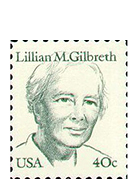May 8 was Mother's Day. In today's article I will be writing about somebody who has been called "The Mother of Modern Management" and "America's First Lady of Engineering." Many of this woman's concepts and ideas lend themselves really well to the Toyota Production System.
|
ADVERTISEMENT |
 Lillian Moller Gilbreth did not study engineering at school. She had a bachelor's degree and a master's degree in literature, and she earned her Ph.D. in the field of psychology. She and her husband Frank, who did not attend college but was admitted to the Massachusetts Institute of Technology, were famous during the early 20th century for their time and motion studies. The Gilbreths were considered to be experts in industrial engineering, and were most likely the first successful management consultant couple.
Lillian Moller Gilbreth did not study engineering at school. She had a bachelor's degree and a master's degree in literature, and she earned her Ph.D. in the field of psychology. She and her husband Frank, who did not attend college but was admitted to the Massachusetts Institute of Technology, were famous during the early 20th century for their time and motion studies. The Gilbreths were considered to be experts in industrial engineering, and were most likely the first successful management consultant couple.
Humanistic Taylorism

…
Add new comment